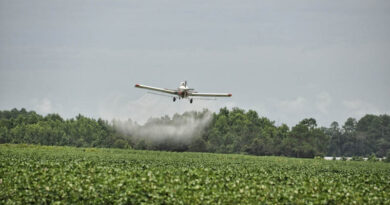Center for Food Safety Blasts “Schizophrenic” EPA Risk Assessment of Dicamba Pesticide
19 August 2022, US: EPA today released its draft ecological risk assessment of dicamba for its registration review of this weed-killing pesticide. Dicamba is the volatile chemical that has caused unprecedented drift damage to crops, trees, vegetable gardens, orchards and ornamentals ever since EPA approved it in 2017 to be sprayed “over-the-top” (OTT) of Monsanto’s soybeans and cotton, which are genetically engineered to withstand it.
Today’s ecological risk assessment is part of the EPA’s registration review conducted for pesticides every 15 years, as mandated by federal pesticide law.
“This latest EPA dicamba assessment is schizophrenic,” said Bill Freese, science director at Center for Food Safety. “The agency admits once again that dicamba has caused thousands of damaging drift episodes, and that attempts to mitigate that damage have failed to stem the harm.” EPA received 3,500 reports of dicamba drift damage in 2021 alone, Freese noted.
“EPA must end all over-the-top registrations of dicamba herbicides, before farmers, beekeepers, rural residents and wild plants and animals experience still another (seventh) year of devastating drift,” Freese said. “There is simply no other solution.”
The drift damage was so extensive that a federal court stepped in to revoke OTT dicamba registrations in 2020, in a lawsuit brought by Center for Food Safety (CFS) and farmers, only for the Trump EPA to resurrect the herbicide four months later. CFS’s challenge to that unlawful decision is underway.
Freese also noted, “EPA continues to gauge risk to wild plants and animals using the same defective models and assessments that entirely failed to predict massive drift harm to crops.”
Troublingly, EPA’s modeling is out of step with real-world experience, falsely suggesting that dicamba sprayed in the traditional way at planting time with conventional crops poses a greater drift threat to plants than over-the-top use on dicamba-resistant soybeans and cotton in the heat of summer. This erroneous assumption makes EPA’s dicamba modeling worthless. EPA must fundamentally revamp its assessment procedures to fully account for “real world” data of massive drift harm in assessing dicamba’s risks to wild plants and animals.
EPA acknowledges that long-term exposure to dicamba can harm bees, but its assessment entirely misses another more serious threat: how dicamba drift decimates flowering plants, robbing bees of their food, nectar, and pollen. This explains why beekeepers in areas hit hard by dicamba drift report huge drops in honey production, particularly in Arkansas and the Dakotas. EPA has still not evaluated dicamba’s risk to endangered plants and animals.
Also Read: ICL and Lavie Bio Enter Strategic Collaboration to Develop Novel Bio-Stimulant Products















